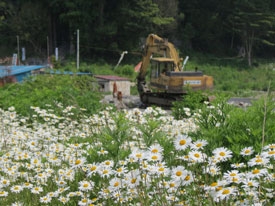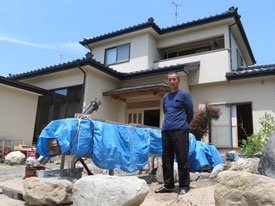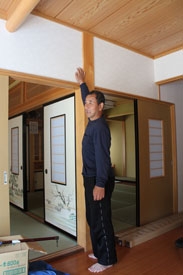The trauma of a tsunami, still fresh for survivors
2013/08/21

By Katherine Mueller
“My father was washed away with his house. I saw the roof of my father’s house float by.” It is this vivid memory, one of many, which Shigeo Kawahara cannot get out of his head. The 59 year old construction worker lives with his wife and daughter in the village of Kiri Kiri in northeastern Japan. On March 11, 2011, the day started out as usual. It would not end that way.
Shigeo would watch as the waves created by the tsunami would creep closer to his community, destroying everything in their path, even reaching high up the walls of his own home which was perched high up on a hill. “My 16 year old daughter panicked and just sat there on the road, shaking,” recalls Shigeo. “I took her and my wife to higher ground and then to an evacuation centre. We now live in prefabricated housing and will stay there until I can rebuild my house.”
The Japanese Red Cross Society is helping tsunami survivors, young and old, work through the emotions left over from that horrific day. It is a process that can take months or years, frustrating those who want to recover quicker. “Moving forward isn’t always the answer. It is okay to simply stand still sometimes,” says child psychiatrist, Dr Junko Yagi. “It is important for people to walk at their own pace.”
Dr Yagi is deputy chief of the Iwate Children’s Care Centre which opened in May with financial support from the State of Kuwait through the Japanese Red Cross. Staff here work daily with children who feel guilty for not being able to save other people; children who cannot concentrate on their studies; and children who have started getting into trouble. “The drastic change of lifestyle and a stressful environment are also causing psychological trauma in children,” says Dr Yogi. “It is important to build a base for children to live safely and peacefully. In order to do that, the adults surrounding them have to be healthy and positive. Therefore, it is important to support not only children but adults in their recovery.”

In Kiri Kiri, volunteers and staff with the Japanese Red Cross helped clear away the physical debris left behind by the tsunami. They also helped clear away the mental and emotional debris, visiting evacuation centres on a daily basis, talking to those whose houses crumbled before them. Today, counselling is offered on a more individual level.
“I lost two family members that day,” says Shigeo’s construction partner, 69 year old Ken-ichi Hanasaka. “People are still suffering from a lot of psychological trauma. They don’t want to talk, not in public anyway. I get counselling in my home, in private.”
“My daughter quit school for two months after the tsunami,” says Shigeo. “She just could not function as she had before. We are very grateful for the counselling she received. It helped us get our daughter back.”
-

Two years after the tsunami and flowers now grow among the ruins of houses in Kiri Kiri in northeast Japan. Residents say they will not move back to the ocean side, and will instead turn the destroyed area into a memorial area.
-
-

Shigeo now lives with his wife and daughter in prefabricated housing and will stay there until he can rebuild his house.
-
-

Shigeo shows how high the tsunami water reached in his home, despite the fact it was perched high on a hill.















